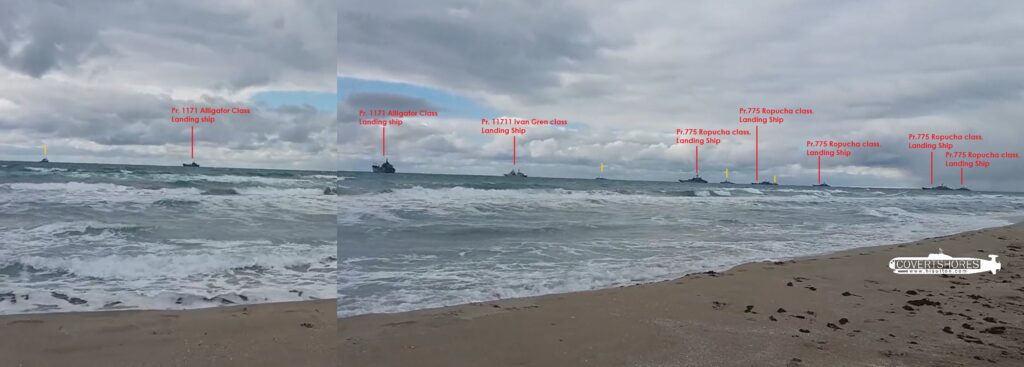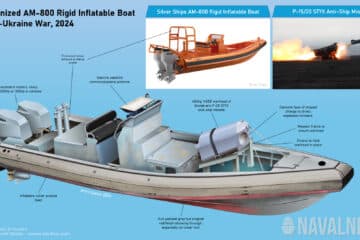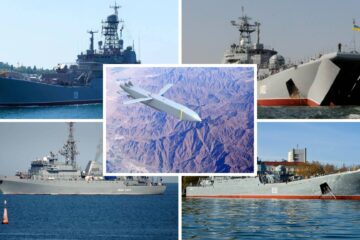The possibility of a Russian amphibious operation has been on the table since the escalation of tensions between Ukraine and Russia. There have been strong indications pointing to a future landing operation, such as the deployment of additional landing ships to the Black Sea, the conduct of naval exercises based on amphibious operations in conjunction with airborne operations, etc.
On the other hand, Naval News recently mentioned in an analysis that an amphibious operation would be a risky decision for Russia, which can dominate the Black Sea without Ukrainian resistance, due to the structure of Ukrainian coasts and the general nature of amphibious operations, which require many casualties.
“Terrain constraints, amphibious lift limitations, difficulty sustaining air dominance, and logistical issues all point to the dangerous nature of any Russian amphibious operation in the Black Sea. As a result, Russia’s decision to start an amphibious operation is solely dependent on how much loss it can tolerate.”
Activities of Amphibious Task Groups
Russia’s amphibious units have been on the scene since the beginning of the war. One amphibious group has been operating in the Sea of Azov, while another, the larger group has been traversing off the coast of Odesa. The force composition is large enough to pose a threat to the coast, but there have been no visually verified amphibious operations to date.
Mariupol Operation
According to USNI’s 25 February report, Russia’s amphibious force in the Sea of Azov launched landing operations near Mariupol. Pentagon Press Secretary John Kirby told reporters that the Pentagon didn’t have “perfect visibility” on the assault and couldn’t provide specific numbers for how many troops Russians landed via landing ships.
The UK Ministry of Defence touched on this subject in an intelligence update feed via Twitter on February 26 and said that Russia has likely conducted an amphibious landing in southern Ukraine between Melitopol and Mariupol.
Though there are intelligence reports from the U.S. and the UK, neither Russian nor Ukrainian officials didn’t confirm a landing operation in the Mariupol region. Moreover, there is no visually verified landing activity while landing, just footage showing a few tanks proceeding on the road.

Three weeks after these claims, Russian forces captured Berdyansk, a port city west of Mariupol, but this invasion was not the result of an amphibious operation. Russian landing ships approached the port after the city had been captured by Russian forces from land.
Amphibious Threat to Odesa

The Russian amphibious task force, which poses a direct threat to Odesa, has been stationed off the west of the Crimean Peninsula since the beginning of the war. The group usually stays south of Donuzlav Bay (probably for protection from the winds and waves coming from the north) and moves west to be visible from the coast, traversing between east and west.
On March 15, there were certain signs of Russia’s preparations for a landing at Odessa. According to H. I. Sutton’s OSINT analysis, three groups of ships were on their way to Odessa, two of which consisted of fighting ships and one of several landing ships.
“The group, forming in an easterly direction, appears to be led by a tug or minesweeper. This ship appears to be towing a minesweeper. Behind it are two Ropucha-class landing ships, another tug, and the following Ropucha.”
H I Sutton, OSINT Analyst
Meanwhile, Russian naval and air forces reportedly conducted missile strikes in and around the coastal city of Odessa. The Ukrainian Defense Ministry states that a total of 90 missiles were fired, several of which were intercepted by air defense systems or landed outside the city. This was counted as a pre-landing phase, called “preparation of the amphibious area of operations” for the landing forces, aimed at breaking Ukrainian resistance to Russian landing forces to reduce potential casualties during the landing.

The movements of amphibious ships, the formation of supporting ships, the use of a minesweeper to guide task group from safe waters, a heavy bombardment of the coastline were clear indications of a landing operation. There were several photos showing Ukrainian preparations to defend Odesa, including tanks and artillery in urban areas ready to attack the coast, and numerous positions on the coast to prevent a landing operation.
Contrary to expectations, Russia did not launch an amphibious operation to Odessa, and the day after the bombardment, the amphibious task group resumed its previous actions.
Assault or Demonstration?

It is difficult to comprehend Russia’s plans for amphibious operations. To understand this, we need to know what Putin has on his agenda, and the most significant point here is how much loss he can risk. However, due to the difficulty of such an operation and the fact that it is a high-loss operation, this option was difficult from the beginning.
On the other hand, the performance of Russian forces in terms of command and control and logistical support did not seem bright so far. At this C2 and logistics level, the outcome of an amphibious operation can be disastrous for Russian amphibious forces. In addition, Russian landing ships are at sea for four weeks, which means that the infantry battalions that are supposed to conduct landing operations are not in good shape. Being stuck in a small landing ship not only causes fatigue but also negatively affects the soldiers’ will to fight.
When these new difficulties are added to the previously indicated hardnesses for an amphibious operation, the likelihood of such an operation decreases. As the war wore on, however, both the cost of the war and the sanctions imposed on Russia by Western countries began to put Putin in a difficult position. When the invasion reaches this level, it seems difficult for Russia to return without getting what it wants. Therefore, will Russia conduct an amphibious operation to break the determination of Ukraine by capturing Odesa, even if it will cause many casualties? It’s hard to say “no”.
So why is Russia wearing out its amphibious forces by keeping them at sea when it is not conducting amphibious operations? In naval literature, this is called an “Amphibious Demonstration“.
“An amphibious demonstration is a show of force that stops short of an actual landing. Demonstrations are conducted to deceive the enemy or, in situations short of hostilities, to signal presence and intent.”
Dictionary of Military and Associated Terms. US Department of Defense 2005.
Russia creates the perception that there is a threat in this region by constantly performing amphibious demonstrations off Odessa, thus keeping Odessa on constant alert, which causes it to keep soldiers in this region. This situation precludes troops waiting to defend the Odessa coastline from supporting forces fighting in other places.
The next weeks appear to resolve Russia’s dilemma in amphibious operations.






